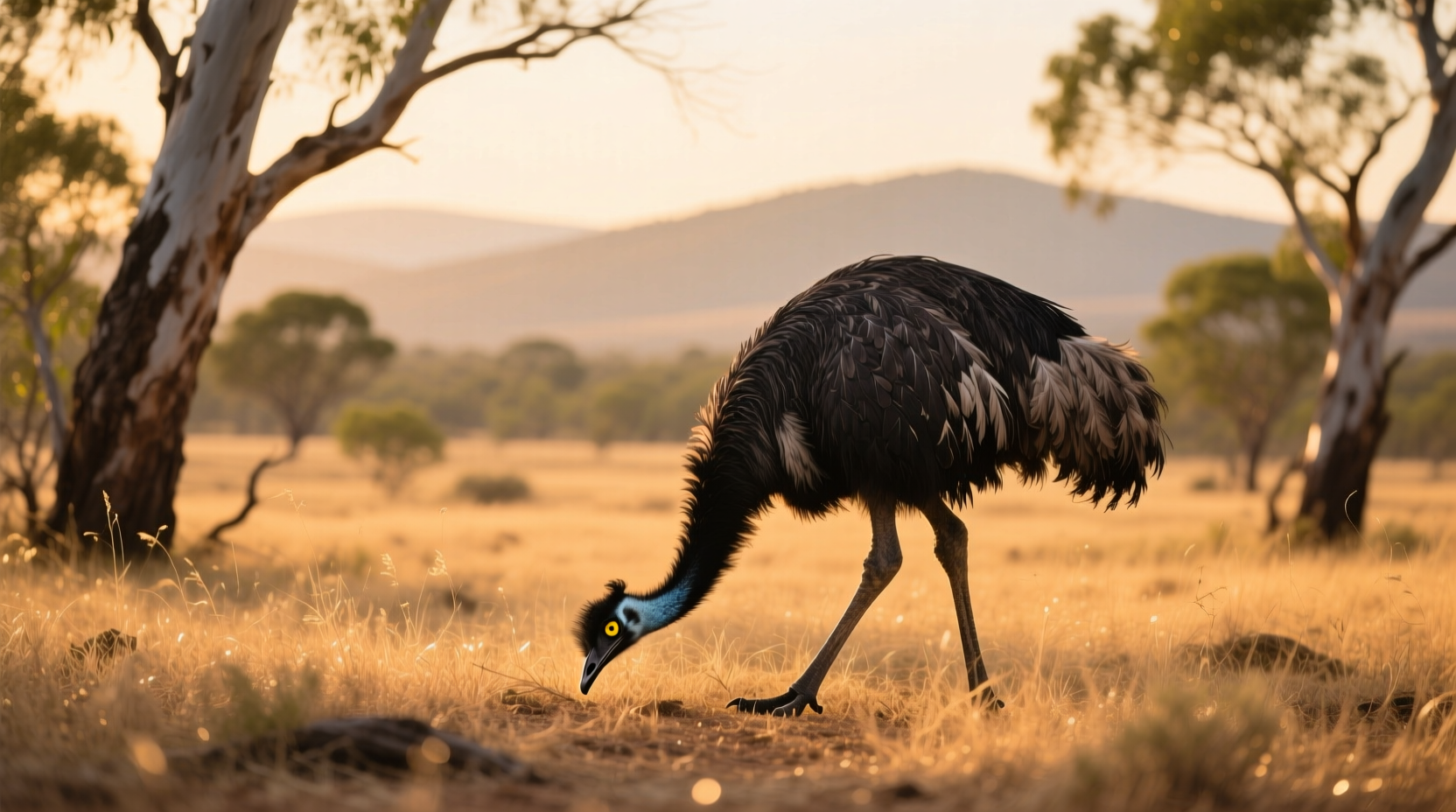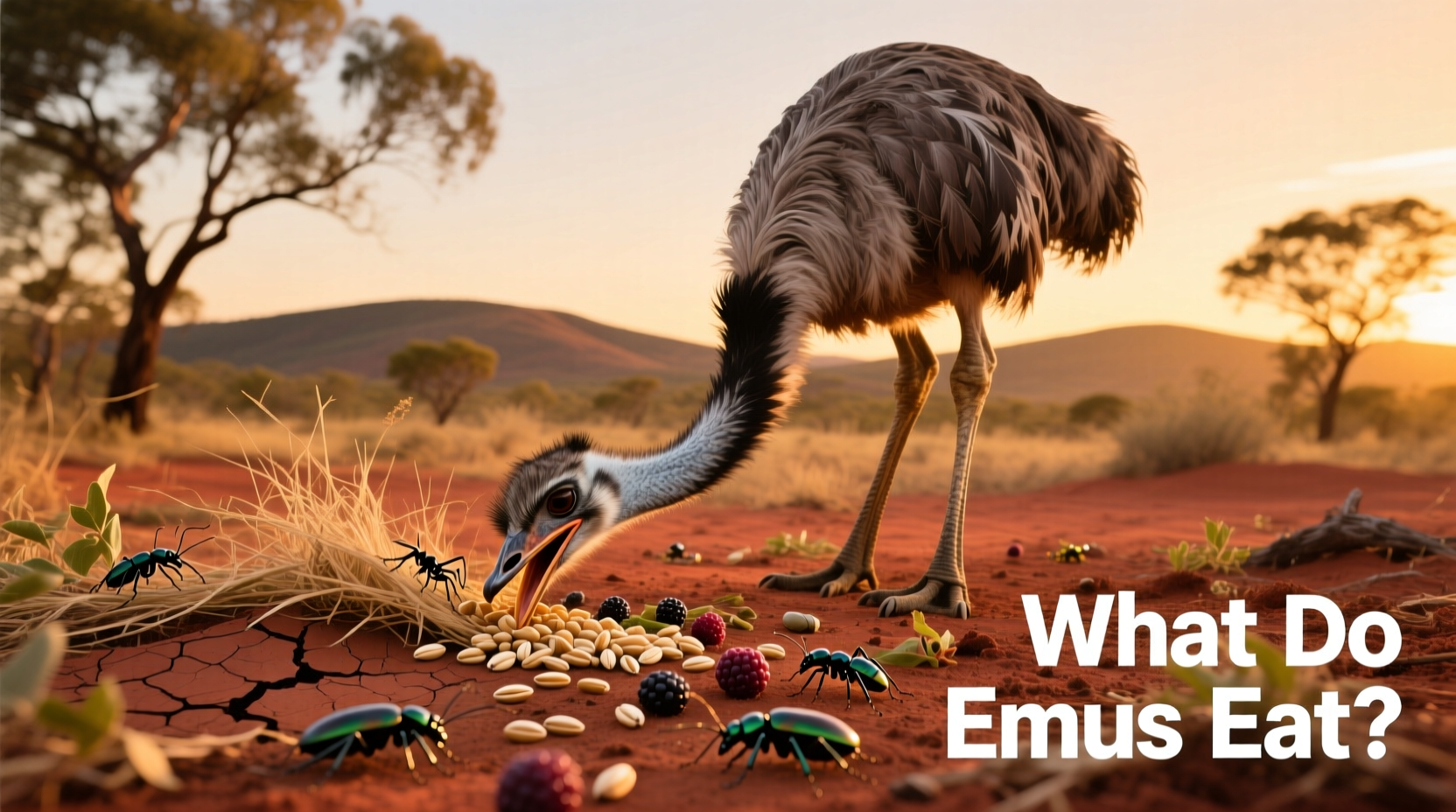Understanding what emus eat is essential whether you're caring for these fascinating flightless birds or simply curious about their natural behaviors. As the second-largest bird species in the world, emus have specific dietary requirements that support their impressive size, rapid growth, and unique physiology. This comprehensive guide details exactly what emus eat throughout their life stages, with practical advice for both wild observation and captive care.
Emu Dietary Basics: Nature's Opportunistic Foragers
Emus (Dromaius novaehollandiae) are native to Australia and have evolved as highly adaptable omnivores. Their distinctive downward-curving beaks and powerful neck muscles allow them to efficiently gather food from ground level while maintaining vigilance for predators. Unlike many birds, emus don't have a crop, so they rely on swallowing small stones (gastroliths) to help grind food in their muscular gizzard.
In their natural habitat, emus cover significant distances daily—sometimes traveling 10-15 miles—in search of seasonal food sources. This constant movement is crucial to their digestive process and overall health. Their diet varies considerably based on availability, with documented shifts between protein-rich insects during breeding season and carbohydrate-heavy fruits during other times of year.

Wild Emu Diet: Seasonal Adaptations
Emus in the wild demonstrate remarkable dietary flexibility that has allowed them to survive Australia's challenging climate. According to research from the Australian Department of Agriculture, Fisheries and Forestry, wild emus adjust their eating patterns based on seasonal availability:
| Season | Primary Food Sources | Nutritional Focus |
|---|---|---|
| Spring | Fresh shoots, insects, small reptiles | High-protein for breeding and chick development |
| Summer | Fruits, berries, seeds, flowers | Carbohydrates and hydration |
| Autumn | Seeds, mature plants, insects | Fat storage for cooler months |
| Winter | Dry grasses, roots, bark | Fiber and sustained energy |
This seasonal adaptation represents a sophisticated survival strategy documented in studies from the University of Queensland's School of Agriculture and Food Sciences. Emus have been observed remembering productive feeding locations and returning to them when conditions improve, demonstrating impressive spatial memory.
Captive Emu Nutrition Requirements
When raising emus in captivity, providing a nutritionally complete diet is critical for preventing common health issues like leg deformities, poor feather development, and reproductive problems. Commercial emu feed should form the foundation of their diet, supplemented with fresh foods.
According to the USDA Agricultural Research Service, properly formulated emu feed should contain:
- 16-18% protein for growing chicks
- 14-16% protein for maintenance in adults
- Calcium-to-phosphorus ratio of 2:1
- Vitamins A, D, and E supplementation
- Appropriate trace minerals
Many emu farmers make the mistake of feeding standard poultry feed, which doesn't meet emus' unique nutritional requirements. Emus need higher levels of certain amino acids and different vitamin concentrations than chickens or turkeys.
Essential Supplements for Captive Emus
Beyond commercial feed, several supplements enhance emu health:
- Fresh produce: Leafy greens, carrots, and apples provide additional vitamins and fiber
- Grit: Small stones (2-5mm diameter) for proper digestion
- Calcium sources: Oyster shell or limestone grit, especially important for breeding females
- Protein boosters: Mealworms or crickets for growing chicks and breeding adults
Water quality significantly impacts emu digestion and overall health. Emus require constant access to clean, fresh water—consuming approximately 1 gallon daily. During hot weather, they may drink up to 3 gallons per day. The University of New England's Poultry Research Unit emphasizes that water containers should be large enough for emus to submerge their heads, which aids in clearing their nasal passages.
Lifecycle Nutrition: From Chicks to Adults
Emu nutritional needs change dramatically throughout their lifecycle. Understanding these transitions prevents common feeding mistakes:
| Age Stage | Diet Composition | Special Considerations |
|---|---|---|
| 0-3 months (chicks) | 20-22% protein starter feed, finely chopped greens | Requires constant access to feed; feed should be in shallow containers |
| 3-12 months (growers) | 16-18% protein grower feed, increasing roughage | Gradually introduce larger food particles; monitor growth rate |
| 12+ months (adults) | 14-16% protein maintenance feed, varied produce | Adjust based on activity level and breeding status |
| Breeding season | 18% protein breeder feed, extra calcium | Begin supplementation 60 days before breeding season |
Chicks require special attention during their first weeks. Unlike many birds, emu chicks don't receive food from their parents. They must find food independently shortly after hatching, which is why providing appropriately sized food particles is critical during this vulnerable stage.
Common Feeding Mistakes to Avoid
Based on data from the American Emu Association's health surveys, these feeding errors cause the most health problems:
- Overfeeding protein to adults: Can cause rapid growth leading to leg problems
- Insufficient calcium: Results in thin-shelled eggs and metabolic bone disease
- Poor water management: Dirty water containers lead to bacterial infections
- Inconsistent feeding schedule: Emus thrive on routine; sudden changes cause stress
- Feeding toxic plants: Avocado, rhubarb leaves, and certain ornamental plants are poisonous
Seasonal considerations significantly impact emu nutrition. During molting periods (typically summer), emus require additional protein to support feather regrowth. In colder months, they need increased fat content to maintain body temperature. The Queensland Department of Agriculture notes that emus naturally reduce food intake during extreme heat, which caretakers should accommodate rather than force-feeding.
Practical Feeding Recommendations
Implement these evidence-based practices for optimal emu health:
- Feed twice daily at consistent times to establish routine
- Provide feed in multiple locations to reduce competition in flocks
- Use wide, shallow feeders that prevent trampling contamination
- Monitor individual birds for changes in eating habits (early illness indicator)
- Adjust portions based on activity level, weather, and reproductive status
Foraging opportunities significantly improve emu welfare. Creating a varied environment with edible plants encourages natural behaviors and provides mental stimulation. The University of Melbourne's Animal Welfare Science Centre reports that emus with access to foraging areas show 30% fewer stress-related behaviors than those fed exclusively from containers.
Recognizing Proper Nutrition in Emus
Healthy emus display these physical and behavioral indicators:
- Shiny, well-conditioned feathers without excessive breakage
- Alert posture with head held high
- Consistent, firm droppings (dark green with white uric acid cap)
- Regular eating patterns without sudden changes
- Appropriate body condition—not overly thin or obese
Regular weight monitoring provides the most objective assessment of nutritional status. Emus should gain approximately 1-1.5 pounds per week during their first six months. Sudden weight loss or failure to gain expected weight warrants veterinary consultation.
Frequently Asked Questions About Emu Diet
Can emus eat fruits and vegetables?
Yes, emus can safely eat many fruits and vegetables including apples, carrots, leafy greens, and berries. These should comprise about 10-15% of their total diet. Avoid avocado, rhubarb leaves, and onions, which are toxic to emus. Always chop produce into appropriately sized pieces to prevent choking, especially for younger birds.
How much do emus eat daily?
Adult emus typically consume 1.5-2 pounds of commercial feed daily, plus additional fresh produce. Chicks eat proportionally more relative to their body weight—up to 10% of their body weight daily during rapid growth phases. Water consumption averages 1 gallon daily but can increase to 3 gallons during hot weather. Always provide constant access to fresh water.
Do emus need special supplements?
Yes, emus require specific supplements for optimal health. Grit (small stones) is essential for proper digestion since emus lack a crop. Breeding females need additional calcium sources like oyster shell. During molting season, extra protein supports feather regrowth. Vitamin E and selenium supplements may be necessary in some regions to prevent nutritional myopathy. Always consult with an avian veterinarian before adding supplements.
What foods are toxic to emus?
Several common foods are toxic to emus including avocado (contains persin), rhubarb leaves (oxalic acid), chocolate, caffeine, and alcohol. Many ornamental plants like azaleas, oleander, and yew are also poisonous. Avoid feeding moldy or spoiled food, which can cause aspergillosis. When introducing new foods, start with small quantities to monitor for adverse reactions.
How does an emu's diet affect egg production?
Diet significantly impacts emu egg production and quality. Breeding females require higher protein (18%) and increased calcium intake starting 60 days before breeding season. Inadequate nutrition leads to thin-shelled eggs, reduced fertility, and lower hatch rates. The Australian Emu Association reports that proper pre-breeding nutrition can increase viable egg production by up to 25%. Consistent feeding schedules and stress reduction also improve reproductive outcomes.











 浙公网安备
33010002000092号
浙公网安备
33010002000092号 浙B2-20120091-4
浙B2-20120091-4